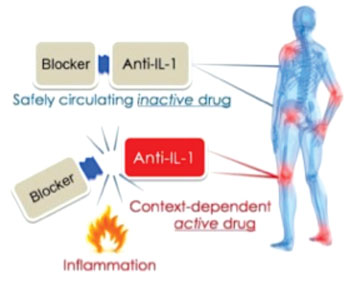Chimeric Drug Reduces Local Inflammation Without Causing General Immune Suppression
By LabMedica International staff writers
Posted on 03 Aug 2015
A novel anti-inflammatory drug is based on a chimeric molecule that avoids general immune suppression by being non-active when injected but is converted into an activate agent by leukocytes concentrated at the site of local inflammation.Posted on 03 Aug 2015
Investigators at Ben-Gurion University of the Negev (Beer Sheba, Israel) and the University of Colorado (Boulder, USA) created the chimeric drug by fusing the N-terminal peptide of interleukin-1beta (IL-1beta) to IL-1R antagonist (IL-1Ra), resulting in inactive IL-1Ra.

Image: The non-active drug is activated when it becomes localized at a site with excessive inflammation (Photo courtesy of Ben-Gurion University of the Negev).
Since the IL-1beta N-terminal peptide contained several protease sites clustered around the caspase-1 site, local proteases at sites of inflammation were able to cleave the chimeric IL-1Ra and turn it into active IL-1Ra.
Results published in the July 8, 2015, online edition of Journal of Immunology revealed that chimeric IL-1Ra reduced IL-1–mediated inflammation in a mouse model of local inflammation. This unique approach limited IL-1 receptor blockade to sites of inflammation, while sparing a multitude of desired IL-1–related activities, including host defense against infections and IL-1–mediated repair.
“This development is important because inhibition of inflammation in a nonspecific manner reduces the natural ability to fight infections and is a common side effect of anti-inflammatory biologic therapeutics,” said Dr. Peleg Rider, professor of clinical biochemistry and pharmacology at Ben-Gurion University of the Negev. “The beauty of this invention lies in the use of a known natural biological code. We mimicked a natural process that occurs during inflammation.”
Related Links:
Ben-Gurion University of the Negev
University of Colorado













